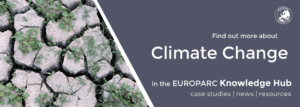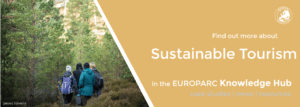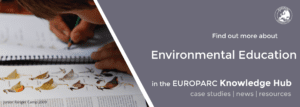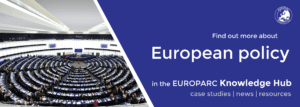Climate change adaptation for Protected Area managers – discussing solutions
Source: Presentation of Cascais’ Action Plan for Climate Change Adaptation
During the Conference 2019 in Latvia, EUROPARC held a number of workshops to discuss diverse topics relevant for Protected Areas management. In case you have not attended, or want to read about their outcomes, a series of online articles summarises their content.
Article by Olivier de Sadeleer, Project Manager LIFE NaturAdapt, EUROPARC.
How do we adapt Protected Area management to a changing climate?
Using 2 case studies from Cascais Ambiente in Portugal and from Teide National Park in Spain, a group of 25 conservation professionals from across Europe discussed and identified key issues and ideas to solve them.
Towards a diagnosis
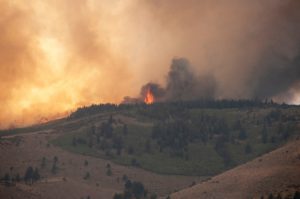
Climate change effects increase the risk of wildfires globally. Photo by Michael Chacon/Unsplash.
KEY ISSUE 1: “FIXISM”
The discussion highlighted that the uncertainty and the changes expected with a changing climate, will “force” Protected Area managers to adapt and change their practice to work in fast-changing circumstances. Flexibility was identified as an issue since the designation framework is usually slow and purposefully rigid. This is further reinforced by he conservation paradigm, which seems to rest on the idea of permanence. The mental image of what Nature we should protect, how it should look like, and what species should be where, appear to be set in stone. On the same lines, many conservation strategies in Europe are aiming at keeping our fragile natural and cultural heritage as it is.
KEY ISSUE 2: LACK OF DECISION SUPPORT SYSTEMS
The group identified a number of shortcomings when it comes to making decisions on meaningful and effective climate change adaptation plans and measures in Protected Areas:
- lack of expertise about climate sciences and cooperation between biologists and climate experts to understand the coming changes and define priorities;
- lack of knowledge and data on the impact of climate changes on species;
- lack of knowledge/examples/data about potential solutions;
- lack of resources and political support to focus on building and implementing a climate change adaptation program on the long term.
KEY ISSUE 3: COMPLEXITY VS SIMPLICITY, A COMMUNICATION GAP
A short inspiring movie by Greta Thunberg and George Monbiot was played to introduce the workshop. It connected the ideas of climate change, biodiversity extinction and nature-based solutions. Reactions by managers allowed us to highlight the third key issue. The communication gap that exists between:
- the need for simplicity of the message to engage communities and political decision makers;
- the complexity of the issues we face and of the solutions one must implement in the field. We work in very complex socio-eco-systems where everything is interconnected. Many stakeholders are involved potentially competing on land use.
Besides those key issues, participants mentioned the existing land ownership structure and land use planning as problematic for the implementation of large-scale efficient and nature-friendly climate adaptation strategies. A significant number of conservation professionals felt that they have little influence (unfortunately) on such topics.
Building up solutions
In a second step, with a different group of 35 people this time, we looked at drafting the foundation of solutions to one of the above issues in a “world cafe” format. The group chose to look at key issue “FIXISM“.
THE DISCUSSED SOLUTION
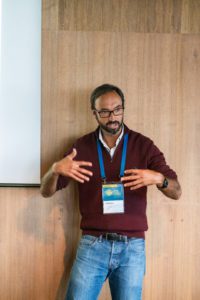
João Dinis presents the benefits that the development of a climate change adaptation plan brought to Cascais ambiente.
The discussion looked into how to support the evolution of the mindset of conservation professionals, experts and policy makers towards a dynamic framework. That paradigm shift should enable nature conservation professionals and local communities to address climate change and biodiversity loss challenges as one.
The transformation of nature conservation education and legal framework and policies were identified as keystones and major steps forward. Concretely, it should evolve to:
– put conservation of natural processes first, before heritage;
– invest in the conditions to have a “functional biodiversity”;
– work on large-scale conservation designations (catchment areas, landscape, …);
– reintroduce the idea of large wilderness sanctuaries where natural processes can operate freely.
Keeping climate change adaptation and mitigation in mind, it is essential to redefin the overarching common goals, on a large scale, for nature conservation and recovery.
WHO SHOULD BE HELD ACCOUNTABLE?
The obvious response of many participants included the policy makers (1), the people who actually write the policies that frame nature conservation practice and funding in Europe. In other words the DGs in the European Commission, the Members of the European Parliament, the National and Regional Environment Agencies. Those actors, together with the different influencers and lobbies do define the framework in which protected area managers then work. Most of what influences policies seems to come from political parties, their scientific advisers, expert groups and NGOs.
As far as education is concerned, participants unanimously agreed that the change should come from professors and researchers (2) in Universities first. There is a limitation to this statement as nature conservation practice as such does not seem to be taught directly in universities. It looks like most Protected Area managers hold degrees in ecology, biology, … and then train as nature conservationists on the job or through continuous education provided by the conservation community (3) through federations, NGOs, environmental agencies…

Participants at the Workshop 5.3 on Climate Change adaptation
Last but not least, the responsibility of change obviously lies with those doing the job everyday, in the field. The Protected Area management teams (4) interpret research findings and legal frameworks to implement conservation action plans in and around Protected Areas. This is good news – it is our own community, the ones with whom we can collaborate.
The conclusion was that this is where we should start.
How do we make it happen concretely?
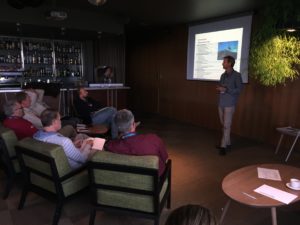
Conference workshop on Climate Change adaptation. Latvia, 2019
The main conclusion is that one way to tackle this challenge is to organise a large-scale debate within the conservation community to co-design a new common vision for nature conservation (or recovery?) in Europe with climate change and biodiversity loss in mind. On top of Protected Area managers, this debate should involve policy makers and universities from the start.
Concretely, there is a need to create a “space” for the debate to happen constructively. It could be a consultation that leverages expert groups, surveys, workshops, conferences, that delivers a common, agreed and ambitious vision for nature conservation in Europe, as well as examples of what a healthy Nature looks like and how it benefits human communities beyond ecosystem services.
A participant mentioned that the EUROPARC Federation with its new strategy could be well suited to host a large-scale debate on European nature conservation in a changing climate.
Conclusion
Climate change is a major threat for Protected Areas. It will bring change and is likely to increase pressure on ecosystems functions. At the same time, it holds the opportunity to innovate and to collaborate on a large scale to put nature back on the agenda.
About the workshop
Workshop 5.3. run at the Europarc 2019 Annual Conference, in Jurmala, Latvia.
Moderator: Olivier de Sadeleer – Project Manager, LIFE NaturAdapt, EUROPARC Federation with the ever-smiling support of Anne-Cerise Tissot, Project Coordinator, LIFE NaturAdapt, RNF
Presenters:
- Case Study Cascais Ambiente: João Dinis – Head of Office for accelerating urban transition in Cascais Ambiente
- Case Study Teide National Park, Jose Antonio Atauri Mezquida – Coordinador de proyectos, EUROPARC España

LIFE NaturAdapt is a 5-year project developed with the support of LIFE, Agence Française de la Biodiversité and Ministère de la Transition Écologique et Solidaire, France.
16 Sustainable Destinations awarded in Brussels
Charter Award Ceremony 2019, EU Committee of the Regions, Brussels
On the 2nd of December, the EUROPARC Federation, the European network of Protected Areas, announced the sixteen Sustainable Destinations of 2019, in a special event hosted by the European Committee of the Regions, in Brussels. Four new Sustainable Destinations were announced at the Charter Award Ceremony 2019, along with the twelve that renewed their commitment this year.
Protected Areas as drivers for Sustainable Tourism
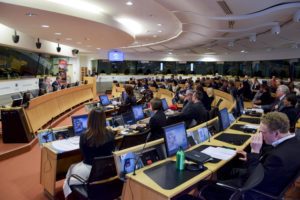
Charter Awards Ceremony 2019 in Brussels.
The event was an opportunity to highlight the role of Protected Areas as catalysts of a sustainable rural development through quality tourism but also to celebrate the collaborative work between Parks and private businesses. The winners of the Star Awards 2019 – the Sustainable Tourism Partners Award were also announced at the event.
In 2019, four new Sustainable Destinations joined the network and twelve current ones renewed their commitment.
Every year, the EUROPARC Federation awards Protected Areas who have successfully applied the European Charter for Sustainable Tourism in Protected Areas methodology, delivering a tourism approach that is good for parks and good for people. To create positive outcomes for local communities, increase economic opportunities, whilst reducing environmental impacts of tourism, are the aims of the methodology managed by the EUROPARC Federation, now implemented by 110 protected areas in 16 European countries. The biggest network of its kind in the world.
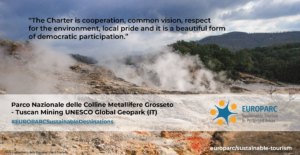
“Sustainable tourism is cooperation, common vision, respect for the environment, local pride, and it is a beautiful form of democratic participation” said the representative of the Italian Colline Metallifere Grossetane National Park who renewed its commitment this year, after being first awarded in 2014.
Sustainable Destinations awarded
The 4 New Sustainable Destinations
- Maremma Regional Park, Italy
- Stelvio National Park, Italy
- Lahemaa National Park, Estonia
- Capcaleres del Ter i del Freser Nature Park, Spain
The 12 Sustainable Destinations that will renew their commitment
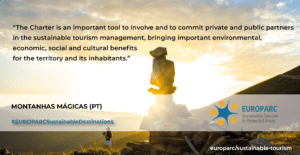
- Loire Anjou Touraine Nature Regional Park, France
- Pallas-Yllästunturi National Park, Finland
- Sibillini National Park, Italy
- Torre Cerrano Marine Protected Area, Italy
- Alta Murgia National Park, Italy
- Pollino National Park, Italy
- Colline Metallifere National Park, Italy
- Appennino Tosco Emiliano National Park, Italy
- Zemaitija National Park, Lithuania
- Sierra Nevada National Park, Spain
- Donana National Park, Spain
- Montanhas Mágicas/Magic Mountains, Portugal
Pursuing continuous improvement
The Charter Award is valid for a period of five years, during which, the Protected Area authority will implement, through a join collaborative work, with its local actors, a strategy and action plan for the territory. However, the process is not over after the first five years of implementation.
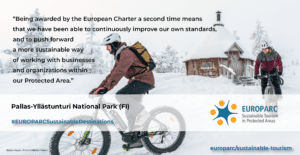
Sustainability requires a long-term commitment, based on the principle of continuous improvement, therefore EUROPARC Sustainable Destinations are invited to assess their performance after the five years of the Award, and redesign a future action plan.
#HabitatHeroes Pioneers from the Peak District National Park
The Peak District National Park in central England is full of diverse landscapes and home to many rare species. It is for example the only place in England where mountain hares can be found. Read about how the Habitat Heroes are looking after the Park’s natural treasure.
Meet our #HabitatHeroes: Junior Rangers of the Peak District National Park
The Peak District National Park runs six Junior Ranger groups. They collected comments from different participants across the different groups and merged them into one case study for the Habitat Heroes campaign.
Tell us all about your “natural treasure”: Which is the species or habitat you learn and work with the most in your Protected Area?
The Peak District landscape is full of natural treasures! In the south of the park, the limestone geology creates amazing rock formations, caves, and provides perfect soil for hay meadows rich in wildflowers. In the North, there are bogs and heather moorland. The heather turns the whole hills purple in summer, and the moorland vegetation makes ideal nesting conditions for ground nesting birds like curlews and grouse.
The park is surrounded by cities so there is a lot of pressure on our natural environment, so it’s important to take care of it!
We are also very lucky to have populations of mountain hares – the only place in England they can be found! These are different from brown hares as they change colour in winter, their fur turning white for camouflage.
The moorlands are a very sensitive environment, and are often damaged by fire (including a hige one last summer that burned for three weeks), so it’s very important that we look after them. In the valleys across the park, there are ancient woodlands, home to many rare bird and plant species.
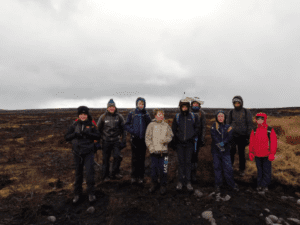
Junior Rangers exploring the moorland in the Peak District National Park
What are you and your fellow Junior Rangers doing (or will do) to learn more and protect your natural treasure? Do you also teach others?
In the Peak District we have 6 junior ranger groups. Our work varies depending on location, as there are different habitats in the different parts of the park! We all learn practical conservation tasks, as well as navigation and bushcraft skills, and help engage other people with the park at events.
Longdendale Junior rangers group have our own woodland area to look after; this year we have planted new trees, coppiced old ones and have built benches using recycled railway sleepers. We have also helped run a community event in the woodlands for local families, running activities such as minibeast hunting and den building to share our knowledge.
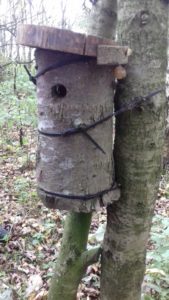
Willow Tit nest box, Junior Ranger Peak District.
We are also inspired by exploring the surrounding hills and moorlands: this year, we have taken expeditions on to the local moors to search for mountain hares, survey peat depth and vegetation, and see the damage caused by the Saddleworth Fire of 2018.
Next year, we’re hoping to build on our skills, with activities to include nest box building, dry stone walling and sphagnum moss planting to help the restoration of peat bogs. The group at Edale have already been working on replanting sphagnum plugs in their own area.
At Marsh Farm, our Junior Rangers group have been focused on helping the Willow Tit, a rare and declining bird that lives in the woodlands around the site. They have surveyed the birds, learnt more about their lives and built nest boxes lined with sawdust to attract them. Some of the nest boxes have been used this year, which is great news!
What do you find tricky being a Junior Ranger – and what is the best thing about it?
What do our Junior rangers find tricky? Some of them say they have found it difficult to balance their school work with coming out at weekends to be part of junior rangers, and others find that rural transport is difficult. Some of our older junior rangers have said they worry about where they will be able to go once they are too old for the groups, so we are looking at developing a follow-on group for young conservationists in the age 18-25.
Our Junior rangers think the best things about it are meeting other people like them, learning new skills and getting chance to explore!
Learn more and keep track of #HabitatHeroes campaign activities!
Since 2018 we are “mapping the field” and raising awareness for the great work Junior Ranger groups are currently doing for threatened flora, fauna and habitats in Protected Areas and Natura 2000 sites in particular.
- Visit the “Habitat Heroes” campaign website: For now, we are thrilled to introduce you to our Habitat Hero campaign pioneers – groups already taking action. You will find a growing map and overview of Junior Ranger groups.
- Besides, you will meet our “Habitat Heroes” in dedicated articles – make sure you follow our news!
- Keep an eye on social media – the #HabitatHeroes will provide you with exciting updates from our Junior Ranger groups that take part in the campaign. Don’t forget to share their actions!
Want to join the campaign? We are happy to learn about your conservation action – just drop us a mail: f.minozzi@europarc.org.
The new EU Commission. EUROPARC Federation is ready to serve!
Plenary Session- Presentation by the Commission President-elect of the College of Commissioners and their programme - Election of the Commission
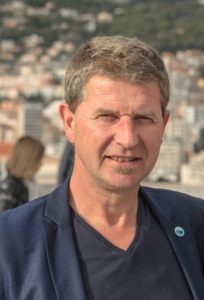
Article issued by Ignace Schops
Yesterday, 27th of November, the European Parliament has elected the new European Commission for the next 5 years, led by Ursula von der Leyen. Read here how the new commissioners are willing to make it the “greenest EU Commission Europe has ever seen”.
Article issued by Ignace Schops, President of the EUROPARC Federation.
In her agenda for Europe “A Union that strives for more” EU President Ursula von der Leyen drafts her 6 headline ambitions and priorities for the next 5 years. With “A European Green Deal” the new EU President is determent what will be the “hallmark” for Europe. EU Commissioner Frans Timmermans will be her second-in-command and lead the European Green Deal.

Ursula von der Leyen by Arno Mikkor
With her team, Ursula will strive to become the first climate-neutral continent, which includes the creation of the first European Climate Law to enshrine the 2050 climate neutrality target into reality. And that’s not all! The new Green Deal includes the protection of Europe’s natural environment, biodiversity, food security, deforestation and land degradation as well.
A new Biodiversity Strategy 2030 will be presented and the EU will take the next step towards a circular economy. A new “Farm to Fork Strategy” on sustainable food along the whole value chain will be developed and President von der Leyen wants Europe to move towards a zero-pollution ambition.
We feel we are moving towards the right direction, towards the right side of development, towards the right side of humanity.
EUROPARC Federation is pleased with the Green Deal. EU President Ursula von der Leyen proposes an inclusive approach, based on the planetary boundaries.
As EUROPARC President, I welcome the EU president Ursula von der Leyen, the EU Vice-president Frans Timmermans, the EU Commissioner for the Environment Virginijus Sinkkevicius and all other Commissioners. EUROPARC Federation is ready to serve, looking forward to working with the EU, Commissioners, and Directorates!
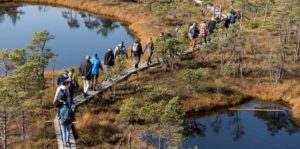
Kemeri National Park, EUROPARC Conference 2019, September 2019
Just a couple of months ago, we were all united in Kemeri National Park in Latvia for your annual conference. This year’s theme “Nature on our mind, understanding our values” was spot on! We could learn, exchange, disseminate our values and desires, our ambitions and opportunities. We highlighted our policy papers and we launched our “Healthy Parks, Healthy People Europe” initiative. But above all we were inspired by the wild wonders of nature and by the power we, as a network, can create. United. To protect, to preserve, to re-connect. Now and in the future.
I am so proud and honored to lead this beautiful federation. Let’s not destroy what keeps us alive! Think globally, act locally and change personally!
